|
|
Volitans Lionfish
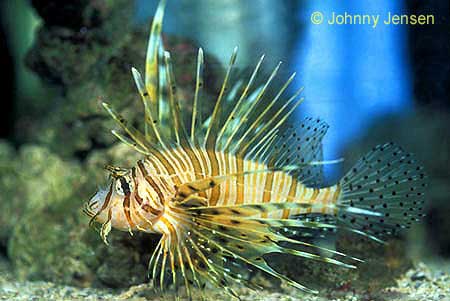
The Volitans Lionfish is also known as the Common Lionfish, the Red Firefish, the Turkeyfish, the Peacock Lionfish, the Scorpion Volitans, the Red Volitans and the Butterfly Cod. The name Red Firefish is no longer appropriate as firefish is a reference commonly used for gobies and the Volitans Lionfish is
definitely not a goby. The Volitans comes from lagoon and reefs to depths of 50 metres in the Indo-Pacific, including the Red Sea. It has even started to appear in the waters off Florida. The Volitans has red/brown or black vertical bars against a lighter background. One bar runs through the eyes. The fins are huge
broad fans and the rays on its dorsal, anal and pelvic fins are hollow spines containing venom. It has a bony ridge across its faces and a pair of tentacles extends from the forehead. Its color pattern can confuse prey into thinking it is a coral.
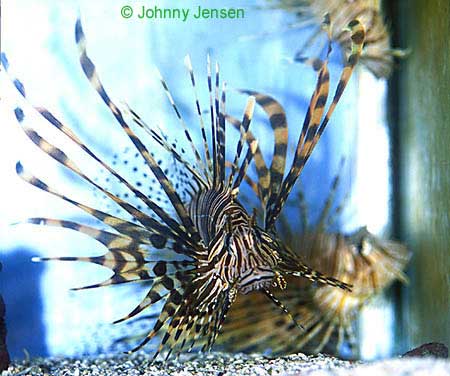
Voitans are a good choice for the intermediate level aquarist, as they adapt well to aquarium life. A tank of at least 100 gallons is easily dominated by a Volitans. They are disease resistant and are almost as good as damsels at surviving bouts of poor water quality. Hiding places and caves should be provided. During the day they will often find a secluded open area and remain motionless with their head down. They will also rest upside down in caves. Volitans will ignore all other fish in the tank unless they see an opportunity to eat them.
The Volitans is a carnivore and eats small fish, shrimp and crabs. They trap their prey by herding them with alternating motions of their pectoral fins. When a victim tries to escape, it is stunned by the spines and then swallowed whole. In the wild they hunt at dusk and can go many days without food. Although Volitans prefer live food, they readily adapt to frozen foods. They are reef compatible, but because they produce large volumes of waste, they are not the greatest choice for a reef tank. Don't overfeed them, do more frequent water changes and watch pH levels closely. Also, do not feed them goldfish despite the Volitans tendency to oblige and swallow these whole. Feeding a couple time a week should be sufficient, despite their desire to feast continually. Over-feeding is one of the biggest problem areas for care of these fish.
Volitans are solitary except when young or when breeding. A male will become darker in color and will attempt to mate with several females. Thousands of eggs are laid in a couple of balls that then drift with the current. The juveniles hatch within 3 days and are free swimming. Breeding in an aquarium is not documented.
The sting of a Volitans is a serious bite, worse than a bee sting. Occasionally this happens by accident while cleaning a tank. If sickness or difficulty in breathing occurs, it is best to seek medical attention. Volitans are quite easy to catch in the wild, as they will not back down from a diver but will attempt to sting them instead.
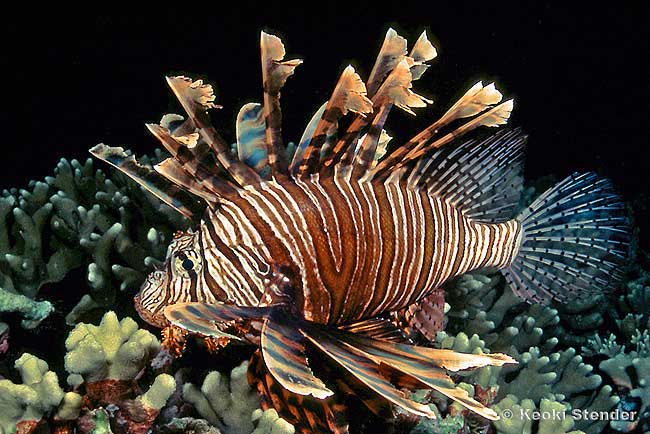
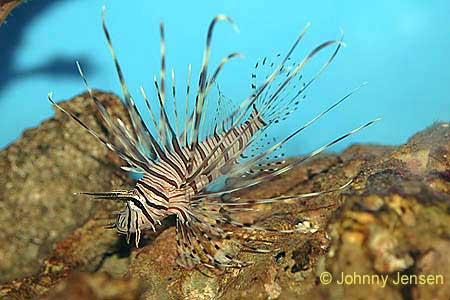
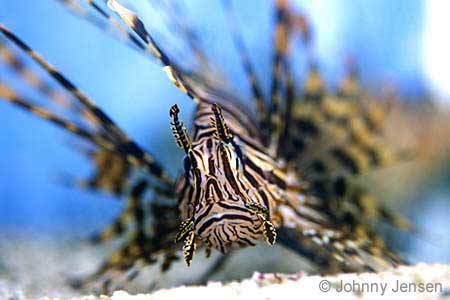
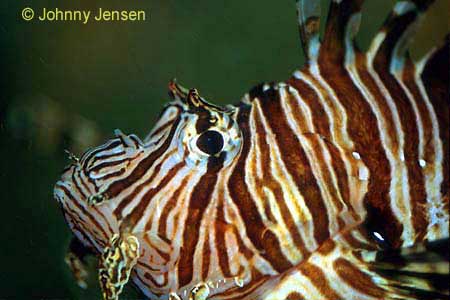
| Scientific Name: |
Pterois volitans |
| Family: |
Scorpaenidae |
| Care: |
Normal |
| Temperature: |
22 - 27 C; 72 - 80 F |
| pH: |
8.1 - 8.4 |
| dH: |
8 - 12 |
| Specific Gravity: |
1.020 - 1.025 |
| Size: |
38 cm; 15 inches |
| Breeding: |
Egg Layer |
| Life Span: |
years |
| Crustacean Safe: |
No |
| Coral Safe: |
Yes |
|
Compatibility:
|
|
Only one lionfish per tank, as they will vigorously defend territory against their own species. A Volitans will eat anything they can sting and fit in their mouth. Tangs, Puffers, Triggerfish and large Angels may be compatible.
|
|